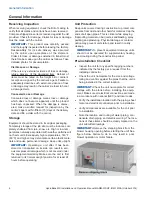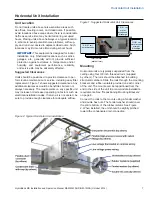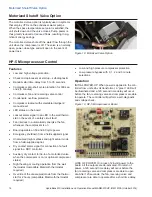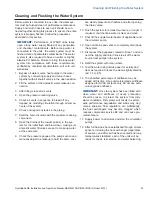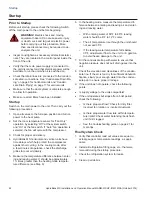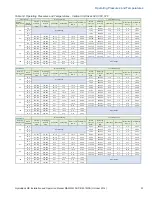
18
HydroBank MS Installation and Operation Manual MAMM-WSHP-IOM-1MSA (October 2014)
HP-5 Microprocessor Control
call for mechanical heating or cooling. Intelligent reset
automatically terminates the lockout mode 5 minutes
after a lockout condition occurs. The purpose of intel-
ligent reset is to allow the unit to attempt to reset itself
if the condition that caused the original lockout corrects
itself. After 3 attempts in a 6000 second (100 minute)
period after the first lockout, the intelligent reset feature
is terminated and the unit stays in lockout until the unit
is manually reset. The number of reset attempts is lim-
ited to protect the unit from severe damage.
OVERRIDE: The override feature is available with the
wall thermostat and is activated by the push button on
the face of the wall thermostat (see Figure 3). When
pushed, the unit will switch back to its normal occupied
temperature set points on the wall thermostat for 2
hours. After 2 hours, the unit will resume its unoccupied
mode operation until the unoccupied mode signal is
removed from terminals “COM” and “NS”. The push but-
ton is only operable when the unit is in the unoccupied
mode.
EMERGENCY SHUTDOWN MODE: Emergency shut-
down allows the unit to be made inoperable via a
remote signal. The emergency shutdown mode can be
activated in two ways:
•
By closing the circuit between terminals “COM”
and “ESD” via a field supplied set of contacts (see
Figure 4).
•
By supplying 24 volts to terminals “COM” and
“ESD”.
In shutdown mode, the reversing valve, fan and com-
pressor are inoperable, the lockout alarm circuits are
activated and the green LED flashes repeatedly 2 times
(quick ON and one long OFF). The unit does not need
to be reset. The signal at terminals “COM” and “ESD”
can be “daisy-chained” between many units. When the
signal to terminals “COM” and “ESO” is removed, the
random start timing function is activated.
AUXILIARY DRY CONTACTS: A pair of normally open
contacts at terminals “DRC IN” and “DRC OUT” shall
close and a pair of normally closed contacts at termi-
nals “DRC IN” and “DRC OUT” shall open when the
compressor is energized. This will allow connection of
24-volt power to the normally closed contacts to supply
power to a normally open (powered close) motorized
valve when the compressor is on.
TEST PIN JUMPER: An on-board pair of male termi-
nals provides for an optional mode of operation which
defeats both forms of compressor time delays. If a hard-
wired jumper is placed across the “TEST” and “TEST
IN” terminals, the random start time delay and the
compressor’s five minutes of anti-short cycle time delay
will be ignored. However, the two, four and six second
time delays on the fan, reversing valve and compressor
remain in place.
LOW PRESSURE BYPASS: The dip switches labeled
“DY1” and “DY2” allow for four different amounts of low
pressure switch bypass: zero, one, two and 3 minutes.
The low pressure bypass timer logic occurs anytime the
board senses a low pressure switch fault.
Testing
FIELD TEST MODE: If the two ‘TEST” quick connect
terminals are connected, there will be no random start
delay, no anti-short cycle delay, and no power to delay
present. The normal fan, reversing valve, and compres-
sor on delays of two, four, and six seconds will still be
present, as well as the four second reversing off delay.
FACTORY TEST MODE: The factory mode is entered
by applying the correct combination of inputs to the
control at power up. The factory test mode operates the
control by associating control outputs with inputs. The
factory test mode is automatically canceled 30 seconds
after control power up and may not be run again until
power is removed from the control.
•
Factory Test Mode Initiation: The control checks
the control inputs during the first 1.0 seconds after
power up, looking for the factory speedup input
combination. To initiate the factory lest mode, at
some point during the first 1.0 seconds after power
up, the high pressure switch input must be active,
the “SENSOR” input must have 470 kΩ connected,
the two “TEST” quick-connect terminals connected,
voltage source must be between 22 to 29 VAC, and
all of the other inputs must be inactive.
•
Factory Test Mode Operation: While in the factory
test mode, the following combinations of inputs will
result in the operation of the corresponding output
conditions:
o
LED stays active.
o
“O” thermostat input active and night setback
input inactive - Reversing valve output active.
o
“G” thermostat input active and emergency
shutdown input inactive - Fan output active.
o
“Y” thermostat input active and high pressure
switch input active - Compressor output active.
o
Thermostat night setback input active and over-
ride input inactive - Alarm output active.



